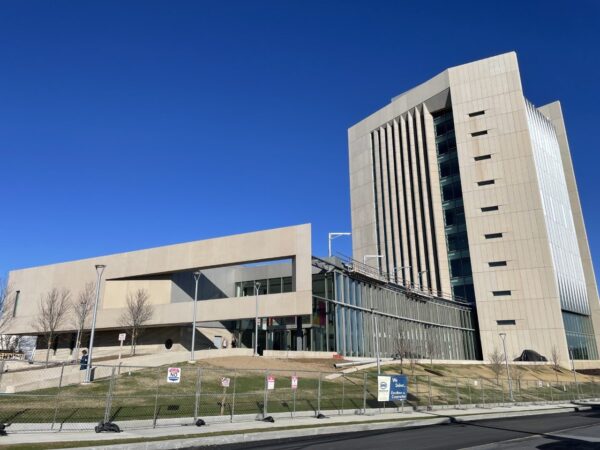
July 15, 2024 | Articles
Construction’s Digital Transformation & The Tools of Modern Project Management

Several recent Hill International contracts reflect a growing trend in the robust hotel market, and the firm’s experience with highly complex, highly visible projects places it in the perfect position for even more work.
Some of the world’s largest hoteliers are turning to Hill to manage the painstaking renovation of some of their flagship properties. Many of these properties are historic or sentimental landmarks, and their renovation is indicative of a growing trend in the hospitality industry.
Such renovations had taken a back seat to new construction, as sleek new hotels rose skyward in emerging markets such as China, India, South America, the Middle East and Africa over the past several years. While construction of new hotels is not expected to slow anytime soon, many hoteliers are turning their attention inward, upgrading, re-tooling and renovating hotels in built-out urban locations or in popular tourist hubs to meet modern travelers’ 21st-century needs.
“In some cases, hotels are changing hands after years in the same portfolio, and the new owners want to renovate to align with their own branding. In other cases, hotel operators or property owners are polishing their existing inventory to bring it in line with what today’s travelers want,” said Dean Sollors, Hill’s country manager in Germany.
Hill recently completed its management of the renovation and modernization of the Steigenberger Hotel in Cologne, Germany. A registered protected landmark, the hotel has been a fixture in Cologne’s historic museums district for more than 50 years. Its mid-century modern aesthetic needed polishing, however, and the entire property needed to be fitted with the latest technologies to make it more sustainable and more attractive to millennials.
The completed, 21,340-square-meter hotel contains 305 modern rooms, as well as a new ballroom and meeting space, and a renovated bar and restaurant. Its post-war, mid-century modern design has been complemented by sleek, sustainable furnishings and décor and modern amenities. In addition, the hotel has been fitted with the latest security and life safety systems, all while keeping its historic elements intact.
The hotel is centrally located near Cologne’s many historic sites and cutting-edge museums, and now boasts a deft mix of sustainable, state-of-the-amenities and technological advances that today’s travelers demand. Lighting, temperature controls and bathroom fixtures use less precious resources and give guests more control over their environments, Sollors said. Public areas and meeting rooms also have been enhanced with new technologies.
“Travelers, especially millennials, are looking for sleek, unfussy design, flexible space, the latest technologies and connectivity, and tangible elements of sustainability,” Sollors said.
Property owner Cologne Value Added, a subsidiary of Spanish investor Azora, retained Hill International to manage the hotel’s modernization. The Steigenberger Hotel Group, an upscale hospitality chain with locations throughout Europe, Eastern Europe, the Middle East and Asia, will operate the completely renovated hotel, which opened in August.
New touches had to seamlessly meld with the existing design, Sollors added. “The complete fit-out of the public areas on the ground floor had to take place while protecting many features of the listed building. For example, work had to proceed without damaging the lobby’s beautiful listed marble floors and columns.”
Sollors said he and the project team are incredibly pleased with the results. “Together, we managed to reduce the completion schedule by six months while maintaining the client’s budget and quality expectations,” he said. “The renovation has returned the property to its place as a premier destination in Cologne, keeping the best of what made it iconic and adding new features that are as functional and sustainable as they are beautiful.”
On the banks of the Nile in Egypt, another iconic hotel has been transformed. Hill International provided project and construction management services during the rehabilitation and conversion of the iconic Nile Ritz-Carlton Hotel in Cairo, Egypt. The hotel has been a Cairo landmark since it was built in 1959. Located near the banks of the Nile River, the 13-story hotel is located in the heart of Cairo’s tourist district, near the Egyptian Museum, the Arab League buildings, and Tahrir Square. The building was the first international hotel constructed after World War II and built under an historic joint venture between the United States and the Egyptian government. It has since hosted dignitaries from throughout the world.
The hotel had operated as a Hilton for more than 50 years, until its owner, Misr Hotels Company, signed a contract with the Ritz-Carlton, and plans began for the complete renovation of the facility in 2008.
The EGP one billion renovation project included modernizing the existing 64,000-square-meter hotel while retaining its architectural and interior design legacy and historic characteristics. The project included renovating the existing main building, which included 331 guest rooms or suites, public areas and food and beverage facilities, demolishing an existing office extension building and shopping mall, constructing a new ballroom and conference center, and adding an underground parking garage. In addition, the hotel infrastructure and engineering building services were replaced with updated systems.
Hill was hired to provide project and construction management services. Renovation work had already begun, but the project was undergoing several challenges, including disputes among the project team members. Hill addressed the issues in dispute, recommended and implemented solutions, and got the project moving again.
Notably, the project and its schedule was affected by multiple work stoppages due to the historic “Arab Spring” revolution in 2011, which took place in Tahrir Square and on which the hotel’s main entrance is located.
“Hill worked with each of the project stakeholders to help preserve site and worker safety during this ongoing event,” said Waleed Abdel Fattah, Hill International’s Regional Manager and Senior Vice President for Africa. “The plan included removal of the site fence and limiting construction work to the hotel’s top floors to avoid any interaction between the contractor’s staff and demonstrators. Hill also negotiated with surrounding police forces on acceptable times and routes for materials delivery, and worked with them to secure materials both during delivery and on the project site.”
In addition, Hill established protocol with the contractor for the safe and expedient entry and exit of more than 1,500 workers. Since all 1,500 workers couldn’t enter or exit the project site at the same time, groups of them entered or exited at pre-determined times, and Hill worked closely with the contractor to ensure that only workers were allowed to enter, and that their entrance and exit was safe.
“Since the hotel was in the middle of the demonstrations, the ground floor of the site was opened up to allow demonstrators to pass through unhindered, which provided a safe route for demonstrators,” Abdel Fattah added. “Opening up the ground floor also greatly mitigated the potential for property damage and violent clashes between demonstrators and workers.”
To mitigate property damage and maximize safety, the hotel’s new curtain wall façade was carefully stored on-site and not installed until after the demonstrations were over. Finally, Hill kept the contractor and other project team members informed of safety and security issues throughout the demonstrations, which lasted 18 days and ended with the resignation of president Hosni Mubarak and pervasive changes in the country’s government.
While no traces of the unrest remain, the Arab Spring has made the hotel even more famous. The reopened hotel is busier than ever. “Today, the hotel has an even greater historical significance,” Abdel Fattah said.
In New York City, design work has begun on the transformation of the historic Jolly Madison Hotel, located in bustling Midtown Manhattan. Built in 1926, the 18-story brick building will be getting a polished façade on the outside, and a complete refurbishment inside.
Hill International is providing owner’s representative services to the NH Hotel Group, which owns and operates the hotel. Based in Madrid, the NH Group is one of the top hotel chains in the world, with more than 400 hotels worldwide.
John Lindell, a Hill vice president and is principal on the Jolly Madison project, said Hill’s services will benefit NH throughout the life of the project. “To date, we have helped the owner select the design professional, we’ve worked with them to generate contracts, and we’ll continue working with them throughout the process. It’s really ‘cradle to grave’ services, especially since the owner is based in Madrid with no permanent staff here in the United States,” Lindell said.
The existing hotel has 243 guest rooms. When renovated, it will contain 289 guest rooms, as well as fully refurbished public spaces. In addition, “the entire infrastructure, is being renovated, including mechanical systems. Existing PTAC (packaged terminal air conditioning) systems will be replaced with unobtrusive, state-of-the-art, four-pipe systems that will allow for heating or cooling in each of the rooms any time of the year,” Lindell said.
“The building also will be completed WiFi-enabled, and guest rooms will have USB charging ports and charging tablets, as well as a European power adaptors,” Lindell continued. “Guest rooms also will be equipped with Lutron dimming controls to control lighting, as well as other sustainable elements.”
“We are also replacing all of the windows in the building, and creating a new façade made of glass brick.” At 60 feet wide by 40 feet high, the façade will be the first commercial application of glass brick in the U.S., Lindell said. “The brick is made of transparent glass; you can see right through it. It will be spectacular.”
Like other historic hotels, the renovated Jolly Madison will blend both new and old. Its ornate brick exterior, designed in the Renaissance Revival style, will be rejuvenated, while its interior undergoes a more dramatic transformation.
“The guest rooms will be very European, with very clean lines,” Lindell said. “The lobby and other public spaces will be very sleek and cleanly designed.”
In central Madrid’s “Golden Triangle,” the Mandarin Oriental Hotel Group and Olayan Europe hired Hill to manage the renovation and modernization of its newly acquired Hotel Ritz, one of the most famous and historic hotels in Europe. Over the next two years, the Group plans to return the hotel to its “Belle Epoque” glory. Built in 1910, the Hotel Ritz has hosted dignitaries and celebrities from around the world. Its vast collection of art and furnishings includes a piano reportedly played by Frank Sinatra for wife Ava Gardner, and a mural inspired by famed Spanish surrealist and hotel regular Salvador Dali.
Work on the Hotel Ritz’s ornate baroque façade, which faces Madrid’s Prado Museum and historic Neptuno Square, already has begun. Work will move inside during 2017, and take more than a year to complete. Plans for the Hotel Ritz’s transformation include the construction of a new pool and fitness center, the addition of a sixth floor, and a revamp of all public areas and guestrooms.
The Hotel Ritz, like Hill’s other hotel projects, will incorporate both innovation and sustainability, with the installation of new mechanical and life safety systems, technological advances, and fixtures that save energy and water. However, the hotel will retain the opulent baroque flourishes both inside and out that have made it an icon.
Hill has been working with the Mandarin and the Olayan Group for the past year, “since the beginning of the negotiations,” said Pilar Pereira, Operations Director of the Hill’s Client Advisory Services Department.
“During the process of buying and selling this emblematic asset, Hill’s Acquisitions Advisory Services Department worked closely with the buyer and the future operator, developing different scenarios in search of maximum profitability, which remarkably shortened the decision-making time,” Pereira added.
“We began by conducting detailed, technical due diligence, which provided the Mandarin with a clear picture of the status of the building, what was needed to transform it and realize their vision, and approximately what that would cost,” added Jeffrey Sujar, Hill Vice President and Managing Director of Western Europe. “Such due diligence is important to every project but, on the renovation of an historic building, it is paramount.”
“Buildings constructed at the turn of the last century were not built in ‘cookie-cutter fashion.’ Each is different, and each is unique, with their own eccentricities and their own challenges,” Sujar continued. “As a result, each renovation project is as unique as the building itself, and needs to be managed that way.”
Lindell agreed. “While each project is different, the budget and schedule of these types of projects require extremely diligent attention. Part of Hill’s services as owner’s representative on the Jolly Madison project involve recommending cost savings where applicable, so that the owner’s vision is achieved while keeping within budget,” Lindell explained. “We instituted a program of ‘live’ value engineering as the design was being established. As the architect specified something, or the owner specified something, we came up with alternatives to achieve the same look and feel they wanted at a lower cost.”
Managing a tight budget and schedule when renovating an older building is a challenge, Lindell said. “We’re taking a ninety-year-old building, which was originally built as a dormitory-style club back in the 1920s, and creating a very modern space inside of it, which is no easy task. Just fitting the new technology into the building and doing it aesthetically is a challenge.”
Lindell has more than 30 years of experience in managing complex construction projects, many of them high-end hotels. “The hospitality market is just booming right now,” he said.
Renovations of older hotels work best when the property is either historic or in a tourist mecca. “It really depends on the location of the existing property,” he said. “The Jolly Madison happens to be in the Murray Hill section of [Midtown] Manhattan, which is the up-and-coming location for this type of development. The neighborhood is becoming a very ‘hot’ place to be. If you have an existing property in the right place, the renovations are definitely worth the cost.”
by Tricia M. McCunney
Share

July 15, 2024 | Articles
Construction’s Digital Transformation & The Tools of Modern Project Management

July 10, 2024 | Articles
GC/CM at Post Falls: Managing Avista’s North Channel Dam Rehabilitation Project

June 23, 2024 | Articles
Irv Richter – An Innovator, A Pioneer, A Leader (1944 – 2024)

June 14, 2024 | Articles
Environment of Care Standards – Meeting the Challenge (Part Two)

June 13, 2024 | Articles
PMO for Public Transit Project Success: The Reopening of Philadelphia’s Franklin Square Station

June 7, 2024 | Articles

May 17, 2024 | Articles
Hill Interim Federal Market Sector Leader Jane Penny Receives Golden Eagle Award

April 11, 2024 | Articles
A Model Move: Managing Move-In at the Sylvia H. Rambo U.S. Courthouse